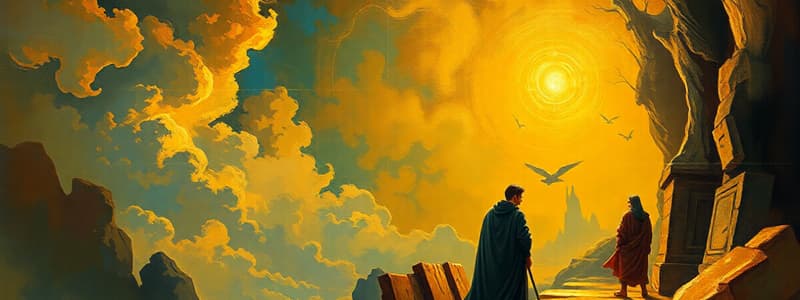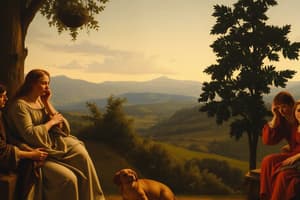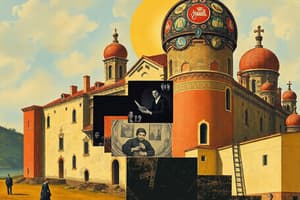Podcast
Questions and Answers
What key characteristics define Early Renaissance painting?
What key characteristics define Early Renaissance painting?
Early Renaissance painting emphasizes simplicity, gesture, and expression.
How did High Renaissance painting differ from the Early Renaissance?
How did High Renaissance painting differ from the Early Renaissance?
High Renaissance painting introduced deepening of pictorial space and more dramatic skies with dark clouds and light.
What are two defining features of Baroque painting?
What are two defining features of Baroque painting?
Baroque paintings are ornate and emotionally appealing, utilizing light and shadow for dramatic effects.
What subject matter did Rococo painting emphasize?
What subject matter did Rococo painting emphasize?
What aspects of life did Romantic painting focus on?
What aspects of life did Romantic painting focus on?
What was a primary aim of 19th-century Modern Art?
What was a primary aim of 19th-century Modern Art?
What distinguishes Impressionism in painting?
What distinguishes Impressionism in painting?
How is Vincent Van Gogh associated with Expressionism?
How is Vincent Van Gogh associated with Expressionism?
What marked the Old Kingdom period of Egyptian sculpture?
What marked the Old Kingdom period of Egyptian sculpture?
Describe a key characteristic of the Middle Kingdom period's sculptures.
Describe a key characteristic of the Middle Kingdom period's sculptures.
Flashcards are hidden until you start studying
Study Notes
Renaissance Painting
- Early Renaissance (14th-15th century): Emphasized simplicity, gesture, and expression.
- High Renaissance (16th century): Depicted deeper pictorial space, dramatic skies with dark clouds and flashes of light.
- Mannerism Period: Employed oil paints of sumptuous, warm, and sensual colors to render the human figure.
Baroque Painting
- Often ornate and fantastic, appealing to emotions.
- Sensual and highly decorative, using light and shadow dramatically.
Rococo Painting
- Focused on depicting farm and country settings.
Romantic Painting
- Captured artists' reactions to past events, historical landscapes, and people.
19th Century Painting (Modern Art)
- Impressionism: Led by Paul Cézanne, who sought simplicity, brilliance, balance, bright colors, and depth in art.
- Expressionism: Led by Vincent Van Gogh, known for rough beauty, emotional honesty, bold colors, and simplicity.
Development of Sculpture
- Pre-historic Sculpture: Rude forms carved from stone and wood.
Egyptian Sculpture
- Old Kingdom Period: Developed into distinct forms that influenced pharonic history.
- First Dynasty Period (5,000 years ago): Depicted the sun, moon, stars, and sacred animals.
- Middle Kingdom Period: Statues depicted individual moods, but bodies remained rigid.
- New Kingdom Period: Life-like and vigorous figures in various poses, conveying dignity and serenity.
- Forms: Palettes, wall carvings, and statues.
Greek Sculpture
- Daedalic Period: Marble was heavily used, with nude male statues common.
- Classical Age (Age of Pericles): Temples were adorned with sculptures.
- Later Greek Period: Male and female figures often shown with little or no clothing. Example: Venus de Milo.
Roman Sculpture
- Depicted famous men and women in busts, aiming for realistic representation of personalities.
Studying That Suits You
Use AI to generate personalized quizzes and flashcards to suit your learning preferences.




